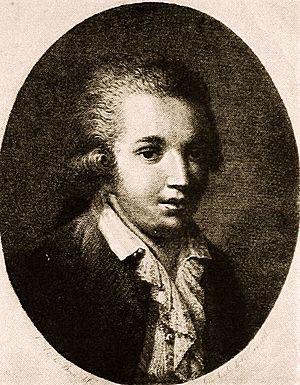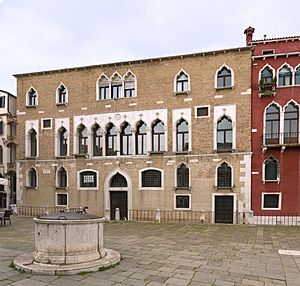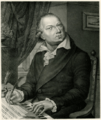Domenico Cimarosa facts for kids
Domenico Cimarosa (born December 17, 1749 – died January 11, 1801) was a very important Italian composer. He belonged to the Neapolitan school of music and the Classical period. He wrote over eighty operas, which are like musical plays. His most famous opera is Il matrimonio segreto (meaning The Secret Marriage), which he wrote in 1792. Most of his operas were comedies, but he also wrote music for churches and instrumental pieces.
Cimarosa mainly lived in Naples, Italy. However, he also spent time in other Italian cities like Rome, Venice, and Florence, writing operas for their theaters. From 1787 to 1791, he worked for Empress Catherine the Great in Russia as her court composer and conductor. Later in his life, back in Naples, he supported a group that tried to change the government. When they lost, he was put in prison and then sent away from Naples. He died in Venice when he was 51 years old.
Contents
Life and Career
Cimarosa's Early Life
Domenico Cimarosa was born in Aversa, a town close to Naples. His family moved to Naples shortly after he was born because his father, Gennaro, a stonemason, found work building the Palace of Capodimonte. When Domenico was seven, his father sadly died in an accident. His mother, Anna, became a laundress for a church, and the monks there helped Domenico get a good education, including music lessons.
He was so good at music that in 1761, at age twelve, he was accepted into Naples's best music school, the Conservatorio di S Maria di Loreto. His teachers taught him composition, and he learned to play the keyboard, violin, and sing. By 1770, he was one of the top students in composition.
Cimarosa started by writing church music. But he became famous in 1772 when his first comic opera, Le stravaganze del conte, was performed in Naples. It was a success, and soon after, he had another hit with Le pazzie di Stelladaura e di Zoroastro. His fame quickly spread across Italy. In 1774, he was asked to write an opera for Rome, where he created another comic opera called L'italiana in Londra. In 1777, he got married, but his wife died the next year.
How Cimarosa Became Famous
Throughout the 1770s and 1780s, Cimarosa wrote many operas for Italian theaters. He was best known for his funny operas, but he also wrote serious ones, like Caio Mario (1780). Besides stage works, he composed music for churches. He became an organist for the royal court in Naples in 1779.
He wrote operas for different theaters in Rome and for La Scala in Milan. His opera La Circe was based on the story of the Odyssey. At some point in the 1780s, Cimarosa married again. His second wife, Gaetana, was his first wife's step-sister, and they had two sons. She passed away in 1796.
In 1787, Cimarosa went to Saint Petersburg in Russia because Empress Catherine II invited him. He was one of several Italian composers who worked for the Russian court. He wrote a serious opera called Cleopatra and updated two of his comic operas. He also composed a Requiem (a type of church music) for Catherine's court. However, Cimarosa wasn't as popular in Russia as some other composers, and he didn't like the cold Russian winters. So, he left Russia in 1791.
After a short stay in Warsaw, Cimarosa arrived in Vienna. His music was already well-liked there. The emperor, Leopold II, made him the court's music director and asked him to write a new opera. This opera was Il matrimonio segreto (The Secret Marriage). It was based on a play called The Clandestine Marriage. The opera was first performed on February 7, 1792, and it was so successful that the emperor had it played again that same evening! Some people call this "the longest encore in operatic history." Cimarosa didn't think it was his best work, but it had a clear story and interesting characters. His own favorite opera was Artemisia, regina di Caria, a serious work he wrote later.
Challenges and Later Years
Cimarosa's music was famous all over the world. He was one of the most popular opera composers in the late 1700s. He wrote 60 comic operas (called opere buffe) and 20 serious operas (called opere serie). Many of his works were performed in cities like Berlin, London, and Prague. Between 1783 and 1790, Joseph Haydn conducted performances of thirteen of Cimarosa's operas. Cimarosa's La ballerina amante was even chosen for the opening of a new theater in Lisbon in 1793.
Just three weeks after Il matrimonio segreto premiered, Emperor Leopold died. The new emperor, Francis II, wasn't as interested in music. So, in 1793, Cimarosa returned to Naples. In 1796, he became the main organist for the royal chapel. He kept writing new operas and updating older ones. He changed some of his operas to include parts in the local Neapolitan language. Important new works from this time include Le astuzie femminili (1794) and two serious operas, Penelope (1794) and Gli Orazi ed i Curiazi (1796).
In 1799, when French troops occupied Naples, Cimarosa supported the group that wanted more freedom. However, the old government soon returned and took strong action against those who had supported the French. Cimarosa was put in prison. He was saved from a death sentence by important people who admired his music. He was then sent away from Naples and went to Venice. He was very ill at this time, probably with stomach cancer. He died on January 11, 1801, at age 51. He was still composing almost until the end, and his last opera, Artemisia, was not finished. There was a rumor that he had been poisoned, but an investigation showed it wasn't true.
What Kind of Music Did Cimarosa Write?
Cimarosa wrote a lot of instrumental music and church music, but he is most famous for his operas. He was known for how easily he could compose music. He often reused parts of his music, which was common back then. Experts say that even with some not-so-great stories for his operas, he created music that was "light, elegant, and refined."
Cimarosa made his solo songs (arias) more flexible. He changed the speed, rhythm, and key to match the words. This made his music feel more natural and spontaneous. His arias often got faster at the end, like a quick finish. He also wrote simpler, more gentle songs. A special part of his music was how he wrote for many voices singing together. In Il matrimonio segreto, for example, there are many duets, trios, and even a big finale where all six characters sing together.
Cimarosa didn't use very new or unusual harmonies. He stuck to traditional musical rules. His musical strengths came from his "rich melodies, bright and energetic rhythms, and always lively accompaniments."
His use of the orchestra changed over time. His earlier works used strings, oboes, horns, and sometimes bassoons and flutes, mainly to support the singers. During his time in Russia, he started using clarinets and made the orchestra's role bigger and richer. In Il matrimonio segreto, the large orchestra adds color and has its own musical ideas that comment on what's happening in the story.
Cimarosa also wrote many piano sonatas, which are pieces for solo piano. These were found in the 1920s. Some people thought there were over 80 single pieces, but it's now believed that many of them might actually be parts of longer, three-movement works. The piece sometimes called Cimarosa's "Concerto for oboe" was actually put together in 1949 by Arthur Benjamin, using parts from Cimarosa's sonatas.
What Did People Think of Cimarosa's Music?
During his lifetime, Cimarosa's fame was huge, almost as big as that of Rossini later on. He continued to be highly respected even into the 1800s. The famous painter Eugène Delacroix even preferred Cimarosa's music to Mozart's! He said that Il matrimonio segreto was "perfection itself." He praised its balance, expressiveness, happiness, tenderness, and "incomparable elegance." The writer Stendhal said that Cimarosa, Mozart, and Shakespeare were the only things he truly loved in life. Stendhal called Cimarosa "the Molière of composers" and claimed to have seen Il matrimonio segreto more than 100 times.
Not everyone loved his music, though. Hector Berlioz, a French composer, didn't like Italian opera much. He said Il matrimonio segreto was "nearly as tiresome as The Marriage of Figaro without being anything like so musical." Robert Schumann, another composer, was impressed by Cimarosa's "absolutely masterful" way of writing for the orchestra, but not much else. However, Eduard Hanslick, a music critic, praised Cimarosa's amazing skill and good taste. He said, "Full of sunshine – that is the right expression for Cimarosa's music."
Images for kids
See also
 In Spanish: Domenico Cimarosa para niños
In Spanish: Domenico Cimarosa para niños





